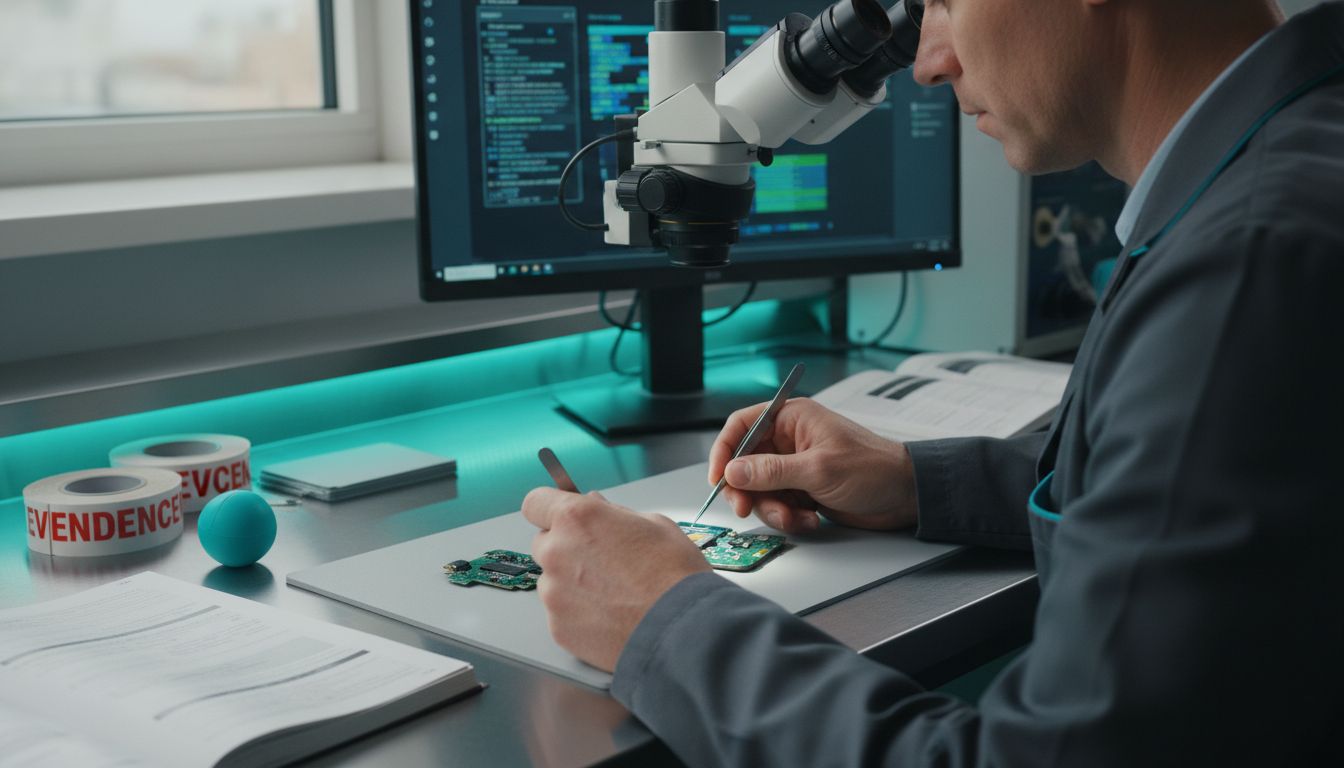Did you know that over 70 percent of smartphones worldwide run on Android? With so much personal and sensitive information locked inside these devices, the ability to uncover digital evidence has never been more critical. Whether investigating crimes or protecting privacy, understanding Android forensics equips people with practical skills and insights for handling today’s high-tech challenges. Effective techniques and specialized tools give investigators an edge in accessing crucial data others might overlook.
Table of Contents
- What Android Forensics Entails
- Types Of Android Forensics Methods
- Key Tools For Android Forensic Investigations
- Legal And Ethical Forensic Responsibilities
- Challenges In Android Forensic Practice
Key Takeaways
| Point | Details |
|---|---|
| Android Forensics Involves Multiple Extraction Methods | Investigators utilize logical, physical, file system, JTAG, cloud, and app data extraction techniques to recover digital evidence from Android devices. |
| Use of Advanced Forensic Tools is Essential | Tools like Cellebrite UFED and Magnet AXIOM are vital for successfully extracting and analyzing data from Android devices. |
| Adherence to Legal and Ethical Standards is Critical | Forensic professionals must maintain evidence integrity, confidentiality, and obtain necessary legal permissions during investigations. |
| Challenges are Increasing with Technology | Modern encryption, ephemeral data, and frequent OS updates pose significant obstacles to traditional forensic methodologies. |
What Android Forensics Entails
Android forensics represents a sophisticated digital investigation methodology dedicated to extracting, preserving, and analysing data from Android mobile devices. According to research from digital forensics experts, this process involves comprehensive techniques designed to uncover critical digital evidence across various scenarios.
The core objective of Android forensics is systematically recovering and examining digital artifacts from smartphones. These investigations typically involve multiple extraction methods:
- Logical Extraction: Retrieving accessible user data through device interfaces
- Physical Extraction: Acquiring complete device memory and system partitions
- File System Extraction: Capturing detailed file structures and configurations
Android forensics professionals employ specialised tools and techniques to navigate complex device architectures. Mobile Forensics Investigations: Digital Evidence Capture From Mobile Phones provides deeper insights into these intricate processes. The investigation focuses on critical data sources like SQLite databases, XML files, and system logs, which can reveal comprehensive user activity records, communication patterns, and potential digital evidence crucial for legal and investigative purposes.
Types Of Android Forensics Methods
Android forensics encompasses multiple sophisticated methods for extracting and analysing digital evidence from mobile devices. According to research from digital forensics experts, these methods can be broadly categorised into software-based and hardware-based extraction techniques, each serving unique investigative requirements.
Key software-based forensic methods include:
Here’s a comparison of key Android forensic extraction methods:
| Method | Accessibility | Data Recovered | Use Cases |
|---|---|---|---|
| Logical Extraction | High (unlocked device) | Contacts Messages Photos |
Standard investigations |
| Physical Extraction | Low (may need bypass) | Full memory Deleted files |
Locked/encrypted devices |
| File System Extraction | Medium | File structures System configs |
App/file-oriented analysis |
| JTAG/Chip-off | Very low (specialist) | Raw data Hidden/deleted content |
Damaged/inaccessible devices |
| Cloud Extraction | Medium to high | Cloud backups Remote data |
Sync with online services |
| App Data Extraction | Medium | App-specific data | Social media/messaging analysis |
- Logical Extraction: Retrieving accessible data through the device’s operating system interfaces
- Cloud Extraction: Capturing data from associated cloud storage and backup services
- App Data Extraction: Acquiring information from specific mobile applications
Hardware-based techniques provide more advanced forensic capabilities. Mobile Phone Physical Data Extraction and Recovery in Digital Forensics Examinations highlights critical methods like JTAG (Joint Test Action Group) and chip-off techniques. These advanced approaches allow forensic experts to access data from damaged, locked, or encrypted devices by directly interfacing with the device’s internal memory chips, enabling recovery of deleted or hidden information that software methods might miss.
Key Tools For Android Forensic Investigations
Digital forensics tools represent critical technologies enabling comprehensive data extraction and analysis from Android devices. These sophisticated software solutions provide investigators with powerful capabilities to recover, examine, and interpret digital evidence across various investigative scenarios.
Key forensic tools for Android investigations include:
- Cellebrite UFED: Advanced mobile device forensic platform
- Magnet AXIOM: Comprehensive digital forensics software
- Oxygen Forensic Detective: Powerful mobile data extraction tool
- MOBILedit Forensic: Specialised data recovery solution
8 Essential Mobile Forensics Tools List for Legal Experts provides deeper insights into these technologies. Notably, products like XRY offer exceptional capabilities, enabling forensic experts to perform both logical and physical examinations, retrieving critical information such as call logs, messages, and hidden system data. These tools employ advanced techniques to bypass device encryption, recover deleted content, and generate comprehensive forensic reports crucial for legal and investigative purposes.
Legal And Ethical Forensic Responsibilities
Digital forensic investigations demand rigorous adherence to legal and ethical standards to ensure the integrity and admissibility of digital evidence. The complex landscape of mobile forensics requires practitioners to navigate intricate legal frameworks while maintaining the highest professional standards.
Key ethical responsibilities in Android forensic investigations include:
- Preservation of Evidence: Maintaining original data integrity
- Confidentiality: Protecting sensitive personal information
- Impartiality: Conducting unbiased, objective investigations
- Consent and Legal Authorization: Ensuring proper legal permissions
Understanding Chain of Custody Procedures highlights the critical importance of meticulous documentation. According to the Scientific Working Group on Digital Evidence (SWGDE), forensic experts must develop comprehensive guidelines that ensure:
- Transparent evidence collection processes
- Comprehensive documentation of all investigative steps
- Protection of individual privacy rights
- Maintenance of forensic evidence authenticity
Stochastic forensics principles further emphasize the need for ethical reconstruction of digital activities, requiring forensic professionals to approach investigations with the utmost integrity and precision.
Challenges In Android Forensic Practice
Digital forensic investigations on Android devices encounter increasingly sophisticated technological barriers that challenge traditional evidence extraction methods. The rapid evolution of mobile technology creates a complex landscape where forensic experts must continuously adapt their investigative approaches.
Key challenges in Android forensic practice include:
- Encryption Technologies: Advanced device security mechanisms
- Ephemeral Data: Rapidly changing and disappearing digital traces
- Multiple Storage Locations: Data distributed across device, cloud, and external platforms
- Frequent OS Updates: Constant changes in Android system architectures
Chanllenges in digital forensics investigations into modern mobile devices provides deeper insights into these complexities. Research highlights innovative techniques like Just-in-Time Memory Forensics (JIT-MF), which addresses stealthy digital attacks by promptly capturing in-memory evidence. Similarly, EviHunter utilizes advanced static analysis to automatically identify evidentiary data, demonstrating how forensic tools are evolving to overcome increasingly sophisticated digital hiding techniques. These approaches help investigators navigate the intricate challenges of extracting reliable digital evidence from modern Android devices.
Unlock the Full Potential of Android Forensics with Expert Support
Navigating the complex challenges of Android digital forensics can be overwhelming. Whether you are dealing with encrypted data, fragmented evidence across cloud and device storage, or the need to maintain strict legal and ethical standards, expert guidance is essential. This article highlights critical methods such as physical extraction and advanced tool usage—areas where specialised knowledge makes all the difference. Avoid costly delays or lost evidence by trusting professionals who understand the nuances of logical, physical, and app-specific data recovery.
Take control of your Android forensic investigations today by partnering with Computer Forensics Lab. Our team provides thorough Digital Forensics Investigation services combining the latest extraction techniques with rigorous evidence preservation. Benefit from our expertise in managing chain of custody and expert witness reporting to strengthen your case. Don’t let complex mobile evidence slow you down. Visit Computer Forensics Lab now to find out how we can support you. Explore more on our Digital Forensics Examination services for comprehensive mobile and device analysis tailored to your specific needs.
Frequently Asked Questions
What is Android forensics?
Android forensics is a digital investigation methodology focused on extracting, preserving, and analyzing data from Android mobile devices to uncover critical digital evidence.
What are the different methods of data extraction in Android forensics?
The main methods include logical extraction, physical extraction, file system extraction, cloud extraction, app data extraction, and advanced hardware techniques like JTAG and chip-off.
What tools are commonly used in Android forensic investigations?
Key tools include Cellebrite UFED, Magnet AXIOM, Oxygen Forensic Detective, and MOBILedit Forensic. These tools help recover, examine, and interpret digital evidence from Android devices.
What are the legal and ethical responsibilities of Android forensic investigators?
Investigators must preserve evidence integrity, maintain confidentiality, conduct impartial investigations, and ensure they have the necessary legal permissions before performing forensic analysis.

